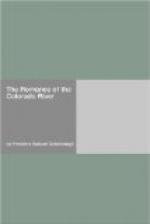On the headwaters of Green River lived the Crows, who called it the Seedskedee Agie or Prairie Hen River. The Snakes and Utes living farther down called it the Bitter-root. Fremont called it the Rio Verde of the Spaniards, but apparently without good authority. It was also spoken of as Spanish River, from the report that Spaniards occupied its lower valleys. Colorado was also one of its names, and this is what it should have remained. The commonest appellation was Green, supposed to have been derived from a trapper of that name. Just when the term “Colorado” was first applied to the lower river is not now known. It bore several names, but finally Colorado took first place because of its appropriateness. Both the walls and the water are usually red, though the name is undoubtedly derived from the colour of the water. Green River is frequently as red as any river could be. After a storm in the headwaters of Vermilion Creek I have seen the Green a positively bright vermilion.
The Arapahos were said to range into Brown’s Park; the Utes were all along the Wonsits Valley and below it on both sides of the river. Then came the Navajos, ranging up to the San Juan and above.* On the north side, below the San Juan, were the various bands of Pai Utes, while on the south were the Puebloan tribes, with the Apaches, Suppais, Wallapais, etc., while still below came the Mohaves, Cocopas, and Yumas, with, on the Gila, the Pimas, Papagos, and Maricopas. The 250,000 square miles of the basin were variously apportioned amongst these tribes, but their territorial claims were usually well defined.
* For notes on the distribution of tribes see the Seventh Ann. Rep, Bu. Ethnology; Wheeler’s Report, vol. i.; Report of Lieut. Ives, Works of H. H. Bancroft, and Garces, by Elliott Coues.
The vegetation of the area, especially that of the lower half, possesses singular characteristics quite in keeping with the extraordinary topography. Here flourishes the cactus, that rose of the desert, its lovely blossoms red, yellow, and white, illuminating in spring the arid wastes. The soft green of its stems and the multiplicity of its forms and species, are a constant delight. It writhes and struggles across the hot earth, or spreads out silver-spined branches into a tree-like bush, or, in the great pitahaya,




